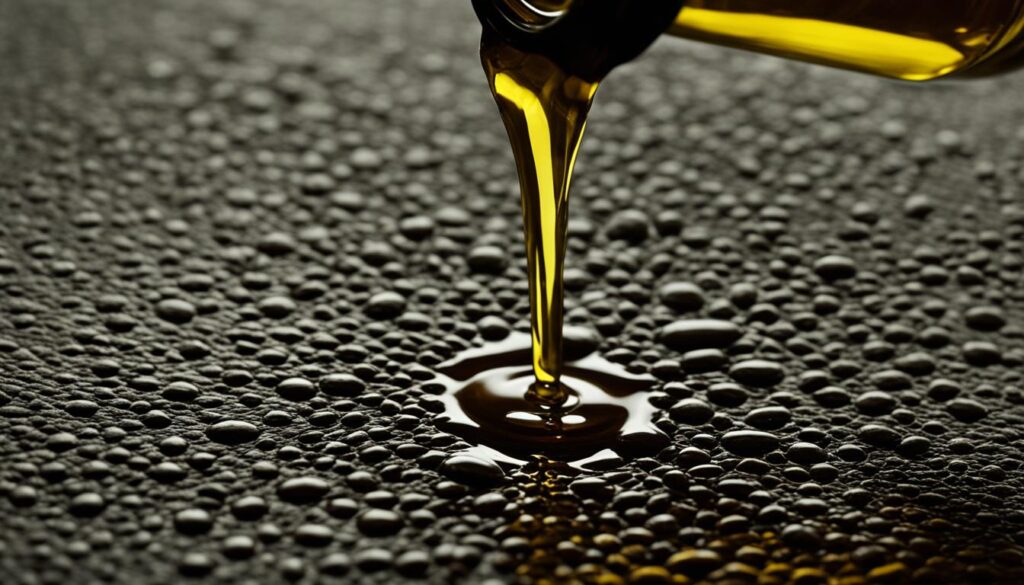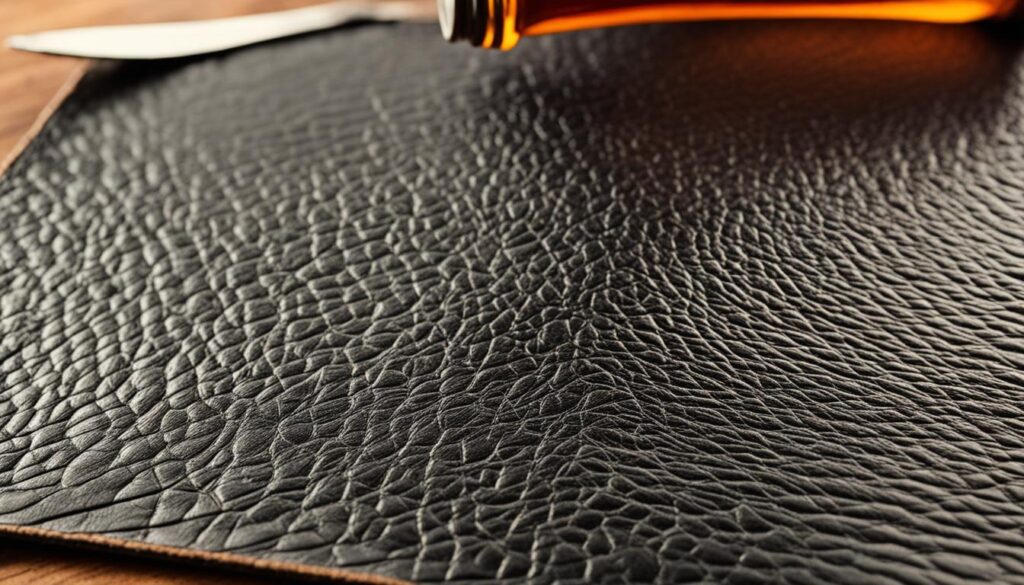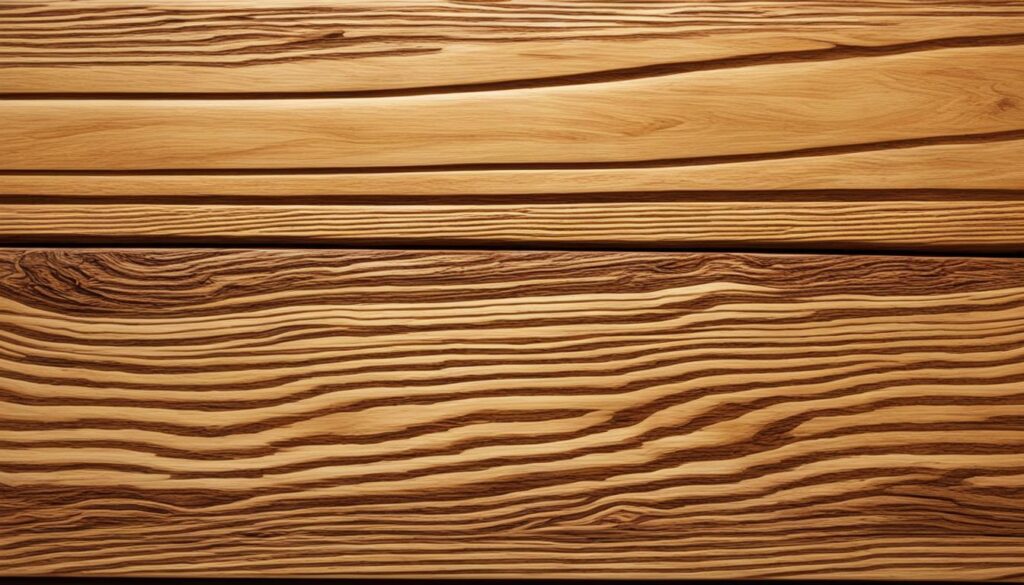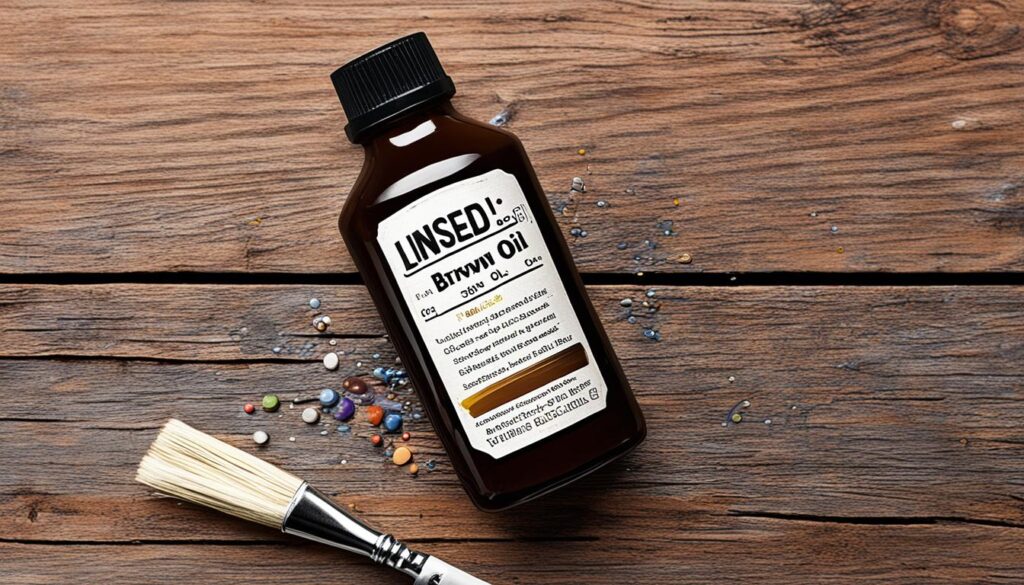Being a lover of leather, I have a lot of it in my workshop. Now, I’m starting a new project with it.1 I want to stay away from things made in factories. Instead, I want to use simple and natural stuff. I know a bit about using oils. But, I’m excited to learn more about how they work.1 I also wonder about the smell of leather. Different oils and treatments can change this smell. “Regular ol’ leather smell” comes from the oils breaking down. Then, special parts of the smell get free.1 I want to find ways to make my leather smell even better for my project.

My journey started with looking into linseed oil. It’s a natural and handy ingredient for leather.1 Linseed oil can make a strong coat on leather. This makes the leather both smell good and feel nice. So, I think linseed oil is the right choice for my project.1
What is Linseed Oil?
2 Linseed oil comes from the seeds of the flax plant. It is used to finish wood, both indoors and outdoors. This oil is loved for being safe to use and good for the Earth. It sinks into the wood, making the grain look beautiful.
Linseed oil is a great pick for natural, eco-friendly wood finishing. It’s good for those who want a3,4 greener option for their projects.
| Characteristic | Benefit |
|---|---|
| Non-toxic | Linseed oil is a safe and natural alternative to synthetic finishes, making it a great choice for indoor projects and areas where toxic fumes can be a concern. |
| Environmentally friendly | As a plant-based oil, linseed oil is a renewable resource that has a lower environmental impact compared to petroleum-based products. |
| Deep penetration | 2 Linseed oil can sink deep into the wood. It protects for a long time and makes the grain look even better. |
Working on furniture, redoing a floor, or protecting your home? Linseed oil is a solid, dependable choice for any of these tasks.
The Many Uses of Linseed Oil
Linseed oil, also called flaxseed oil, is very useful and all-natural. It is used in many ways. It’s not just for wood finishes. It’s a key part in lots of jobs and daily tasks.
In woodworking, it goes deep into the wood. It makes the grain look better and adds a strong, protective layer. But its job list doesn’t stop there.
As a5 paint binder, it helps make colors that last. The paint won’t crack or fade easily. It’s also in5 putty to keep it flexible and sticky.
Linseed oil also makes a shiny5 varnish for all sorts of surfaces. It’s great for looks but also helps as a5 lubricant. This means it can lessen the wearing down of machines and tools.
Believe it or not, it’s good for you too when taken as a4 nutritional supplement. It has healthy oils that help your heart and skin. And for4 treating leather, it’s perfect. It keeps the leather soft and looking natural.
If you work with wood, paint, or want natural products, linseed oil is essential. Its many uses truly make it special.
Popular Types of Linseed Oil
Linseed oil comes in three main types: raw, polymerized, and boiled. Each one works differently based on the project. For example, raw linseed oil is good for a natural wood look.
Raw Linseed Oil comes straight from flax seeds. It takes longer to dry but looks great on wood.5
Polymerized Linseed Oil speeds up the drying. It’s great for projects that need to finish quickly but still look good.
Boiled Linseed Oil dries even faster, mostly thanks to metal driers. You can cover 10m² to 20m² with a liter, based on how much the surface takes in. It usually dries in about a day.5 Boiled linseed oil comes in many sizes. It’s good to use it within two years of opening. Keep it between 7 °C and 20 °C for best results.5
All linseed oils are drying oils, meaning they turn tough when they meet air. They are perfect for many uses, like wood and leather finishing.
There is also a food-grade linseed oil. It’s safe for things that touch food, like cutting boards.5
Can You Use Linseed Oil on Leather?
Yes, linseed oil is great for leather. It’s a top pick for6 treating and conditioning. It sinks deep into the leather, feeding it and keeping it safe.6
Linseed oil was used to make patent leather, which is strong and shiny.6 It has linoleic acid, good for making the oil work well with leather.6 In comparison, neat/neatsfoot oil has oleic acid, which is different from linseed oil.6
When linseed oil is used on vegetable tanned leather, it smells great at first, like leather, and this scent goes away in a day.6 The oil makes the leather look shinier over time, improving in color and brightness where applied.6
Experts often pick neatsfoot oil over linseed to soften leather.4 They say to use neatsfoot oil a lot, let it sit for a day, and redo it a few times over a few weeks.4 They warn against boiled linseed oil.4 For best results, use raw linseed oil.4
There are also great commercial products like Leatherique and BMW conditioner for leather.4 Lexol is also praised for cleaning and keeping leather seats nice.4
Mixing neatsfoot oil and anhydrous lanolin can help restore firm leather.4 The mix should feel like yogurt, and you should put it on a few times.4 Warm weather helps or add some heat to let leather soak it in.4 People say this works well for fixing leather.4

Linseed Oil as a Leather Treatment
Linseed oil is great for treating linseed oil as leather treatment. It soaks into leather well, making it strong and protecting it.5 About 10m² to 20m² can be covered with 1 liter, depending on the leather. It dries in about 24 hours for each coat.5 You can buy it in sizes from 250ml (8.5 fl oz) to 5ltr (176 fl oz). Keep it between 7°C and 20°C.5
Using linseed oil makes leather last longer leather conditioning. It goes deep into the leather, keeping it soft and looking good.5 Linseed oil works on many things, like wood, kitchen tools, and stone.5
Linseed oil doesn’t just go into the leather, it also makes a shield on top linseed oil polymer coating. This shield protects from the sun and water, keeping the leather nice for longer.5
| Linseed Oil | Neatsfoot Oil |
|---|---|
| Linseed oil is good for making leather soft. But Neatsfoot oil works better to make it look new.4 | For softening leather, use 50% Neatsfoot oil and 50% Anhydrous Lanolin.4 Put it on until the leather won’t soak up more and then wipe it off.4 |
| Some people don’t like using linseed oil on leather because it smells strong. They say there are newer ways to take care of leather.4 | Mixing Neatsfoot oil and Anhydrous Lanolin makes a thin mix good for leather.4 Putting this on in the summer makes leather softer faster.4 |
To sum up, linseed oil is a good pick for leather conditioning and leather protection. It dives deep into the leather and makes a shield. This helps keep leather beautiful and strong for a long time.
Removing Oil Stains from Leather
Oil and grease stains are tough on leather. Yet, there are many ways to fix this problem. Leather can absorb a little oil without ruining the material7.
Stains from foods like almonds cause oil stains. Olive oil and sauces do too. Thicker oils from soybeans can make really stubborn stains on leather7.
To clean oil stains, you can use everyday items. Talcum powder and corn starch work. Baking soda, dishwashing liquid, and white vinegar help too7.
Suede is softer than regular leather. So, it gets affected by oil more easily7.
Faux leather is synthetic but clean it like real leather. Use rubbing alcohol or nail polish remover7.
Full-grain leather can absorb a lot of oil. This can make it stain easily but look better with the right care8.
Top-grain leather is more protected against oil. It has a layer that helps. But, if it’s exposed to oil for a long time, it might still stain8.
Genuine leather is not as good with oil. It can get damaged and look uneven if oiled. This is because it’s made from many pieces stuck together8.
Bonded leather gets easily hurt by oil. The oil can make the glue weak, causing it to fall apart8.
It’s important to know which leather you have. This helps you know how to deal with oil stains. Different leathers show oil stains in various ways, affecting their look and feel8.
If you spill oil on leather, act fast. Blot the oil as soon as possible. This stops the leather from soaking up the oil too deep. It helps keep the leather looking good8.
Quickly dealing with oil can save your leather. It stays beautiful and useful this way. Start by knowing your leather type and stain for the best cleaning results8.
Homemade Leather Cleaners
You can make useful homemade leather cleaners with things from around your house.9 They often include simple mixtures, like water and white vinegar in equal parts for a basic clean. Or, a mix of one part vinegar with two parts linseed oil for a more natural conditioner.9 For a clean, use mild stuff like vinegar with water. For a condition, try natural oils like linseed.9
Spills or accidents from pets, food, or kids need quick cleanups to avoid damage.9 Some messes can be managed at home, but for big stains or faded spots, a pro might need to step in.9 Don’t use strong chemicals, waxy products, or too much water. This will help your leather furniture stay in good shape.9
Be sure to use a good leather conditioner every 6-12 months. For pieces that get heavy use, you might need to condition more often.9 Keeping your leather furniture clean and cared for is key.9

| Cleaning Method | Ingredients | Process | Expert Tips |
|---|---|---|---|
| Natural Oils | 2 tablespoons of coconut oil or olive oil | Warming the oil, cleaning the leather, patch testing, application, and buffing | Emphasize the right cloth for application and managing excess oil10 |
| Beeswax and Butter | Beeswax, Shea/Cocoa Butter, and Sweet Almond/Olive Oil | Melting, mixing, cooling, prepping leather, patch testing, application, and buffing | Highlight the importance of cooling the mixture before application10 |
| Natural Baby Soap | Natural Baby Soap, Warm Water, White Vinegar | Creating the mixture, wiping leather gently, and allowing natural drying | Recommend natural drying and caution against exposure to direct sunlight10 |
| Vinegar and Linseed Oil | White Vinegar and Linseed Oil | Crafting the blend, shaking for consistency, preparation, patch testing, application, and buffing | Advise testing on inconspicuous areas due to possible darkening effect on leather10 |
Safety Considerations
Linseed oil is safe to use, but there are things to remember. It’s non-toxic, says the Material Data Safety Sheets.11 Still, it can be flammable and might get hot while drying.11
It’s wise to work with linseed oil in a well-ventilated area. This helps avoid breathing in too many fumes.11 Boiled linseed oil isn’t safe for food. It will come with a warning.11 Always dump used linseed oil safely. And, take care to stop spills or fires.
Linseed oil has a good side too. It’s full of omega-3s, which are good for you.11 Plus, it’s earth-friendly, water-resistant, and tough. It mixes well with many other oils.11
Source Links
- https://leatherworker.net/forum/topic/66995-oils-in-leather-chemistry/
- https://sharprazorpalace.com/stropping/8269-linseed-oil-strops.html
- https://thecraftsmanblog.com/the-ultimate-guide-to-linseed-oil/
- https://www.corvetteforum.com/forums/c3-general/1910312-linseed-oil-to-soften-leather.html
- https://www.leatherrepaircompany.com/products/boiled-linseed-oil-retail
- https://leatherworker.net/forum/topic/70496-natural-leather-finishes/
- https://steelhorseleather.com/blogs/the-journal/how-to-get-oil-stains-out-of-leather-useful-guide
- https://eikenshop.com/blogs/leather-guide/how-to-get-oil-out-of-leather
- https://www.coit.com/blog/general-home-cleaning/how-clean-leather-couch
- https://eikenshop.com/blogs/leather-guide/diy-leather-conditioner
- https://www.quaggadesigns.com/post/linseed-oil-wood-non-toxic
Welcome to WoodCraftYard.com, your one-stop destination for all things woodworking! I’m Oliver Candler, a dedicated woodworking aficionado and the creative mind behind this virtual woodworking haven. With a deep-rooted love for craftsmanship and a keen eye for detail, I am on a mission to share my passion for woodworking with fellow enthusiasts like yourself.
As a seasoned woodworker, I am committed to providing you with valuable insights, practical tips, and inspiring project ideas to help you unleash your creativity and master the art of woodworking. Whether you’re a seasoned pro or just starting out on your woodworking journey, join me as we carve, sand, and saw our way through the world of woodworking together.
Let’s embark on this woodworking adventure, where every knot, grain, and finish tells a unique story. Together, let’s craft, create, and build something truly extraordinary at WoodCraftYard.com!


